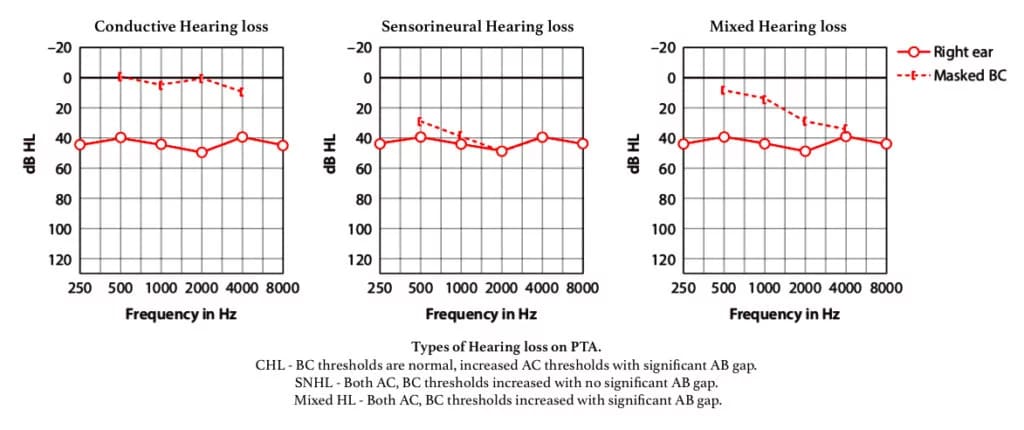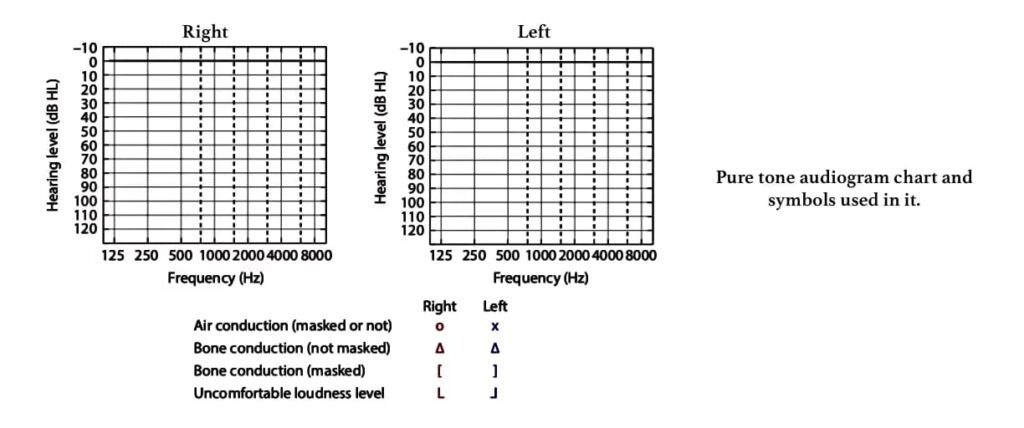Pure Tone Audiometry (Gold standard). Pure tone audiometry is a subjective test to measure the hearing threshold for pure tones (i.e., sinusoidal waves with a single frequency, amplitude & phase) using an instrument called audiometer. It is an electronic device which produces pure tones, the intensity of which can be increased or decreased in 5 dB steps. At each frequency, the threshold intensity is determined and charted in the form of a graph called audiogram.
A Pure tone audiometer consists of following main parts:
- Electronic oscillator. It can generate pure tones of frequencies ranging from low to high.
- Intensity dial. It helps to adjust the threshold intensity of hearing for each tone.
- Headphone. It helps to deliver the pure tones of various frequencies to each ear separately.
Pre requisites:
- Pure tone audiometry should be performed in a sound-proof room (accepted level of ambient noise < 35 dB).
- Transient noises (sneezing, coughing or of any movement) should be avoided as it may interfere with the test results.
- The patient sits in a sound-proof booth and the examiner performs audiometry from outside the booth. They should be able to talk to each other through intercom or directly.
- The examiner and the patient should sit face-to-face so that the examiner is able to see the patient’s reactions (discomfort, state of confusion, not able to recognise sound etc).
Procedure: The better ear is tested first. The threshold for each pure tone is measured in the order: 1000Hz, 2000Hz, 4000Hz, 8000Hz followed by 500Hz and 250Hz. In case the difference between contiguous frequencies is 20dB or more, inter-octave frequencies (750,1500,3000,6000 Hz) must be tested. Similarly, testing is done in the other ear. Testing is carried out by AC first and then, if necessary, by BC. Test frequencies for BC are those in the range 500–4000Hz, with no retest at 1000Hz required.
Bracketing technique/10dB down, 5dB-up technique/ descending-ascending technique: Each test signal is delivered at an audible level, followed by attenuation in volume(in 10dB steps) until the signal is inaudible. Then the signal is increased in steps of 5 dB until it becomes audible and the patient perceives.
Pure Tone Audiogram is a graphic representation of hearing detection thresholds in each ear.


| MASKING. Masking is done to produce inaudibility of one sound by the presentation of another sound. During masking, one ear is kept busy by a narrow band noise when the other is being tested. Masking of the non-test ear is done in all bone conduction tests because BC signals are transmitted to both cochleae, regardless of the side on which the transducer is placed. However, for air conduction tests, a continuous masking noise (or masker) is required only when the interaural hearing difference (AB gap) exceeds 40 dB or more (when using supra or circum-aural headphones), or 55 dB or more (when using insert earphones). This is done to avoid transcranial transmission/ interaural attenuation/ cross-hearing and accurately measure hearing in each ear. |
Interpretation of PTA.
- Conductive hearing loss. There is a difference of more than 10dB between AC and BC thresholds at any frequency.
- Sensorineural hearing loss. The BC thresholds are raised above 20 dB HL.
- Mixed Hearing loss. If the BC thresholds are raised above 20 dB HL and there is a significant ABG, this is referred to as a ‘mixed’ hearing loss.
Utilisation of PTA:
- The primary purpose is to determine the type, degree, and configuration of hearing loss. AC pure tone audiogram is the primary test to measure the degree of hearing loss. BC pure tone audiogram aids in differentiating between conductive and sensorineural hearing loss. If the hearing loss for AC and BC is equal, it indicates a sensorineural lesion whereas AC > BC indicates a conductive lesion.
- PTA confirms the degree of handicap for medicolegal purposes.
- Audiogram is essential for accurate prescription of hearing aid.
- PTA determines speech reception threshold of the subject.
Disadvantages of PTA:
- It is a subjective test (results are based on the subject’s answers).
- PTA gives inaccurate results in case of a malinger.
- The results are not reliable in a child of age <7 years as it depends on cognitive development and cooperation.
——— End of the chapter ———
Learning resources.
- Scott-Brown, Textbook of Otorhinolaryngology Head and Neck Surgery.
- Glasscock-Shambaugh, Textbook of Surgery of the Ear.
- Logan Turner, Textbook of Diseases of The Nose, Throat and Ear Head And Neck Surgery.
- Rob and smith, Textbook of Operative surgery.
- P L Dhingra, Textbook of Diseases of Ear, Nose and Throat.
- Hazarika P, Textbook of Ear Nose Throat And Head Neck Surgery Clinical Practical.
- Mohan Bansal, Textbook of Diseases of Ear, Nose and Throat Head and Neck surgery.
- Anirban Biswas, Textbook of Clinical Audio-vestibulometry.
- W. Arnold, U. Ganzer, Textbook of Otorhinolaryngology, Head and Neck Surgery.
- Salah Mansour, Textbook of Comprehensive and Clinical Anatomy of the Middle Ear.
- Susan Standring, Gray’s Anatomy.
- Ganong’s Review of Medical Physiology.
Author:

Dr. Rahul Kumar Bagla
MS & Fellow Rhinoplasty & Facial Plastic Surgery.
Associate Professor & Head
GIMS, Greater Noida, India
msrahulbagla@gmail.com
